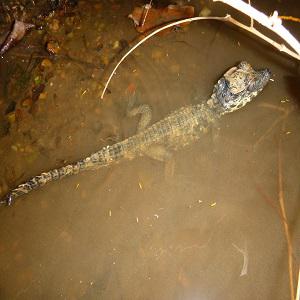Daniel Konzin
This project aims to assess the population status and distribution of these crocodilians while enhancing their conservation values through environmental awareness campaigns.

Hatchling of Osteolaemus tetraspis spotted in Tano-Offin Forest Reserve
Crocodiles have received little research and conservation efforts in Ghana mainly because of perceived danger, funding difficulties and lack of expertise. Consequently, most of what we know comes from anecdotal data obtained from incidental observations made by researchers working on other fauna (Shirley and Oduro, 2008). The Draw River and Tano-Offin forest reserves consist of diverse habitats that serve as home to many threatened species, including the Critically Endangered Mecistops cataphractus and the Vulnerable Osteolaemus tetraspis (McCullough et al., 2005; Shirley et al., 2009). However, there is no baseline data on the population and distribution of these species in this region of Ghana. Unfortunately, our preliminary investigation indicates that the reserves are threatened with agricultural encroachments, illegal mining and exploitation for food. Hence this project aims to assess the population status and distribution of these two crocodilians while educating fringe communities and other key stakeholders to enhance understanding about crocodiles in order to ensure their long-term persistence.

Team leader admiring Osteolaemus tetraspis hatchling in Tano-Offin Forest Reserve
The study will use both diurnal and nocturnal spotlight surveys methods (Webb & Smith, 1987) to thoroughly search for crocodiles within wetlands, rivers and other suitable habitats in the reserves. A GPS receiver will be used to take the coordinates of all crocodiles encountered, including nesting sites. This data will be used to develop a distributional map for the species using ArcGIS. We will develop a standard questionnaire to interview local hunters, traders and consumers on the quantity of crocodiles harvested per annum and other factors such as habitat destruction and human-crocodile conflicts. We will raise awareness about crocodiles and their habitats through radio broadcast programmes, workshops, video shows and educational presentation in fringe community schools.
This work will help draw both local and international conservation attention towards the plight of M. cataphractus and O. tetraspis in Ghana and West Africa at large. The project will also contribute to the protection of the entire ecosystems. Aside from M. cataphractus and O. tetraspis, there are other rare and threatened species that inhabit the project areas including Endangered amphibians (Phrynobatrachus annulatus and Phrynobatrachus ghanensis), the Critically Endangered Cercopithecus roloway and the Vulnerable Agelastes meleagrides (McCullough et al., 2005). Through capacity building of the local stakeholders and conservation awareness creation, we will develop collaborative support not only for the protection of the crocodile species but the ecosystem as a whole.